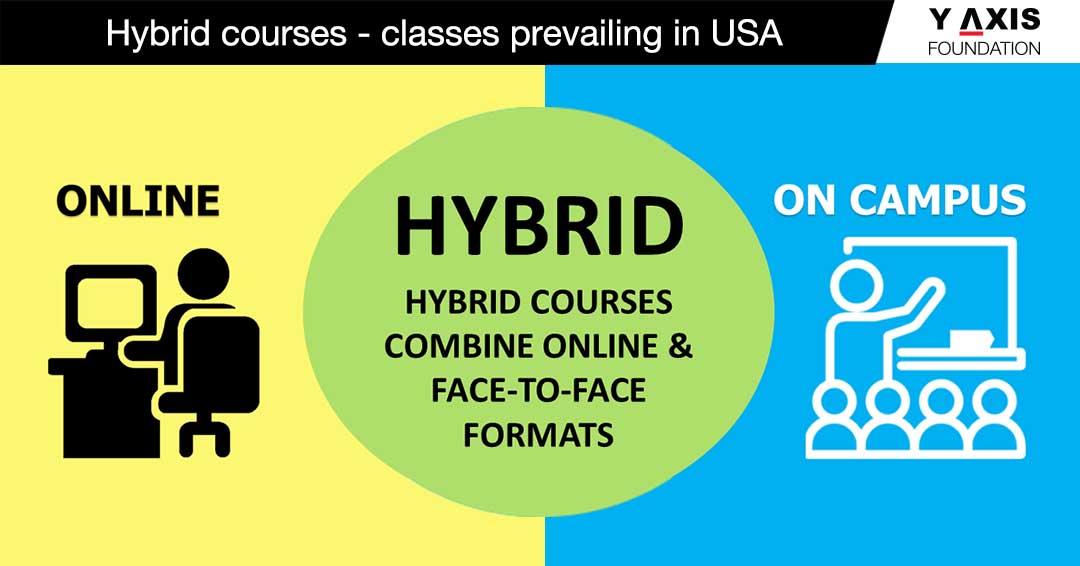
Hybrid courses (also known as blended courses) replace a portion of traditional face-to-face instruction with web-based online learning (e.g., video lectures, online discussions, or activities) during this COVID period in the U.S.
It varies from institution to institution on what should be the proportion of online hybrid classes and face to face direct interaction session. According to a U.S. Department of Education meta-analysis of online learning strategies, hybrid courses produced better outcomes than fully face-to-face courses.
Hybrid classes do require time spent face to face, but the amount of time in the classroom is significantly less than traditional classes, allowing students to balance work, a social life, extracurricular activities, or even attending other classes. It merely replaces the class period that you don’t have to physically attend. You will still be expected to complete the same amount of work that you would if you were in a traditional class.
Hybrid learning combines the properties and positive aspect of both face to face classrooms and online learning and gives a solution towards new education system. Hybrid learning system recognizes the strengths of integrating verbal and text-based communication and makes a unique fusion of both.
It proportionately mixes the synchronous and asynchronous, direct and mediated mode of communication, online and face to face instruction of teaching and learning in a systematic method to make it more effective.
Perhaps the most important and challenging aspect of designing and teaching hybrid courses is to properly integrate in-person and online activities. Designing an effective hybrid course does not simply mean adding an online component to a face-to-face course
In this module interaction will be more structured. Interaction among the students, between the students and instructors, between students and the course content is considered while designing the program.
Learner content interaction: This is the foundation of learning. This is the basic as students interact with the courses, subject matter and content they are supposed to learn. There is an option to pause to comprehend the learning.
Learner instructor interaction: Communication between the students and the instructor, delivers information, encourages feedback. In hybrid courses instructor plays a role of facilitator.
In such classes one has to create activities that encourage student interaction and collaboration: discussion forums on class material/topics, online chats where students interact with each other, group projects that support collaboration and active learning (for example, have small groups edit a wiki together), invite students to share screen and present etc.
Models of Hybrid Course Design:
Face-to-face driver: The instructor lecture-based class where teaching learning discussion is done face to face.
Online driver: The instructor places lectures online using screencasts or other streaming media for students to review and then students use these materials to engage in face-to-face activities. Often these face-to-face activities include group discussions, problem-based learning, and/or other active learning techniques.
Lab rotation: The instructor typically sets a consistent schedule whereby students learn material online via video lectures and/or activities and then come to lab for hands-on learning. Some face-to-face labs may also be replaced by virtual, online ones.
Flex: The first few weeks of the course generally are comprised of face-to-face preparation followed by an extended period (such as a month or more) of online work.
Benefits of Hybrid Courses:
- It eliminates space constraints and reaching out issues by replacing in class contact hours with online activities.
- Expands access and more options for students
- Helps to build more capacity of accommodating and maximizes the use of instructional resources.
- Mediates between face to face and fully online courses and create a comfort level for both instructors and students.
- Integrating the out-of-class with in-class activities, which allows for more effective use of traditional class time and provides more opportunities for all students to participate.
- It is more affordable and accessible.
- It is mainly useful during COVID era.
Challenges of Hybrid courses
- Integrating face-to-face and online learning activities requires the instructor to re-evaluate course objectives and approaches.
- Managing both in-person and online environments can be initially difficult
- Many students may not be able to manage or be technically equipped to follow the new system. Many might find it difficult to cope simultaneously with face to face and online education system.
- Initially there may be questions regarding the quality of this new education methodology.
Some of the Universities in USA that already implemented Hybrid learning system:
- North Eastern University
- Harvard University
- Stanford University
- University of Chicago
- University of California
- Texas A&M University
- Georgia Tech University
- Cleveland State University
- Penn State University
- Carnegie Melon University
- University of South Florida

Hybrid courses – classes prevailing in USA
Posted on August 1, 2020